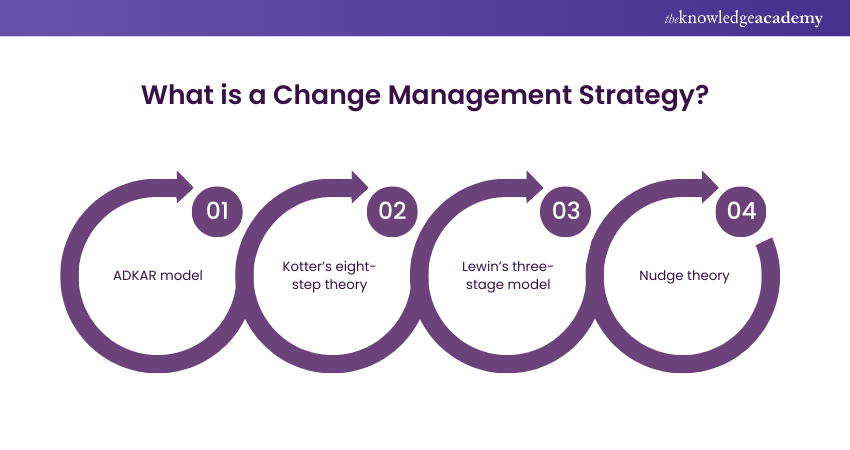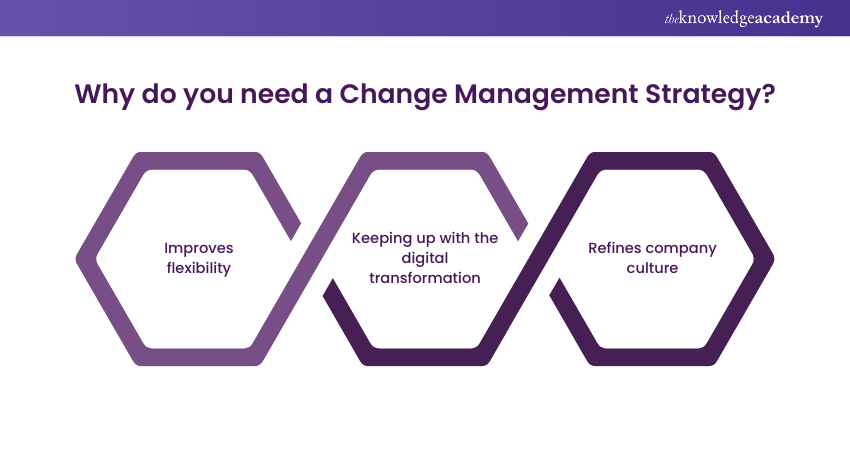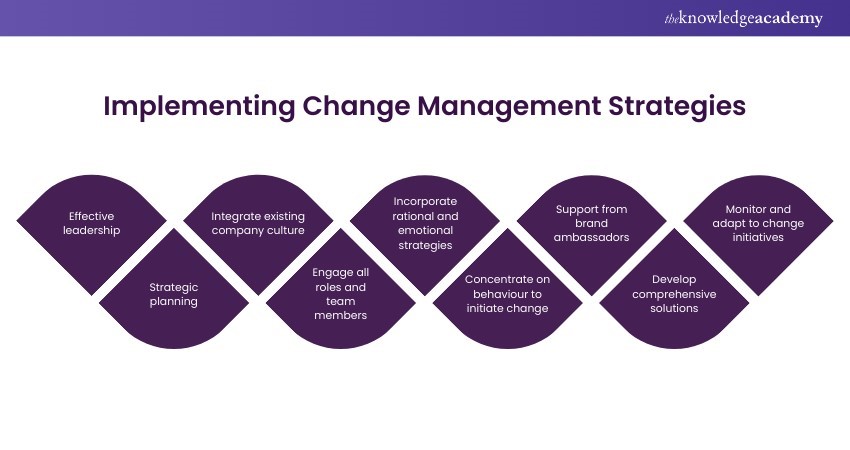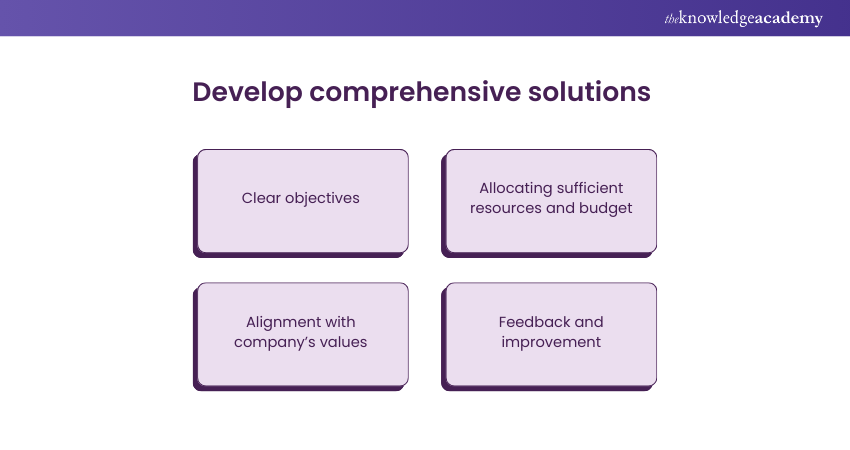We may not have the course you’re looking for. If you enquire or give us a call on +48 221041849 and speak to our training experts, we may still be able to help with your training requirements.
Training Outcomes Within Your Budget!
We ensure quality, budget-alignment, and timely delivery by our expert instructors.

Change Management can significantly improve the quality of your business and organisation through proper planning, implementation, and monitoring of changes. This can be achieved by implementing an effective Change Management Strategy. It is a plan prepared to welcome the various changes to the organisation. Drafting the perfect strategy for it is a vital step in ensuring effective Change Management.
The tendency to resist change has been consistent among individuals and organisations. But, according to Statista, 49.7% of organisations around the globe have stated that they are open to the idea of adopting change for the betterment of the company. In this blog, you will learn about Change Management Strategy, why you need it, and how to implement it.
Table of Contents
1) What is a Change Management Strategy?
2) Why do you need a Change Management Strategy?
3) Types of Change Management Strategies
4) How to implement effective Change Management Strategies?
4) How do you create a Change Management Strategy?
5) How do you measure the success of Change Management?
6) Conclusion
What is a Change Management Strategy?
A Change Management Strategy, incorporating Change Management best practices, is a detailed plan designed to ensure the seamless implementation of changes within a business or organization. These changes may include adopting new technology, enhancing processes, or introducing new products. An effective strategy for managing these changes is crucial for their successful administration.
The best Change Management Strategies have been sourced from good Change Management models. These models are frameworks or concepts that guide you through the process of introducing changes and implementing them. Some of the commonly used Change Management models and theories are as follows:

1) ADKAR model: ADKAR stands for the five goals that the company must aim for – Awareness, Desire, Knowledge, Ability, and Reinforcement. It prioritises the people going through the change.
2) Kotter’s eight-step theory: This commonly used theory focuses on maintaining enthusiasm for change. The eight steps include creating a sense of urgency, building a change team, forming a strategic vision, communicating the vision, removing barriers, focusing on short-term wins, maintaining momentum, and instituting change.
3) Lewin’s three-stage model: This model can be used to break down significant changes into smaller parts. It follows three steps - unfreeze, change, refreeze – to denote how your current process must be ‘unfreeze’, made changes to, and then ‘refreeze’ following the changes.
4) Nudge theory: The Nudge theory refers to giving subtle messages that ‘nudge’ you to change. The concept is centred around the idea that people adapt to change better when allowed to embrace it instead of feeling forced slowly.

Why do you need a Change Management Strategy?
Change Management Strategies significantly improve the success rate of the Change Management Process in organisations. Here are some reasons why your organisation needs a strategy for Change Management:

Improves flexibility
Change is unavoidable. In a world where businesses need to evolve to stay in the game constantly, organisations need to be prepared to welcome changes on various levels. A good Change Management Strategy helps you be ready for potential changes driven by external and internal factors.
For instance, factors like inflation can affect the functioning of a business. But, if you have a strategy that offers solutions for money-related situations, the problem can be solved quickly.
Market conditions are susceptible to change constantly, and if you cannot change with it, your business can face colossal losses. Having a strategy ready for handling the changes helps you apply changes easily and makes you more flexible to future changes.
Get Paid What You Deserve! Find out the latest change manager salary data. Learn More!
Keeping up with the digital transformation
Digital transformation refers to the processes used to integrate technology in business to improve efficiency and customer experience. Companies keep shifting to the latest technology to stay relevant.
Upgrading to better technologies comes with multiple benefits, like an increase in productivity via streamlining processes, better data analysis and insights, and improved communication. Strategies for managing change help you stay one step ahead of your rivals in today’s competitive business world.
Refines company culture
Introducing changes to organisations is an elaborate process, and it starts with convincing the stakeholders, drafting a plan, conveying the idea to everyone, implementing, and monitoring it. The primary asset of any organisation is people.
Thus, details about the change must be conveyed properly to everyone to be on the same page. When people feel like they are being prioritised and acknowledged, their interest in instilling the changes and working with them increases.
This will result in a high productivity rate, improving overall business performance. Change Management Strategies guide you through multiple processes like effective communication, which helps people understand changes better and enhance company culture.
Ready to lead and drive success? Enroll in our Change Management Certification program to gain the skills and credentials you need.
Types of Change Management Strategies

Three different types of Change Management Strategies can be used to improve the functioning of your organisation, which are as follows:
Developmental change
Developmental change strategy refers to introducing small changes to a process or product currently in use to make it more effective. This is one of the commonly used Change Management Strategies due to using current processes with no new additions, thereby minimising the scope for risks. One primary example of this strategy can be software upgradation or an additional training program that aims at improving certain skills of employees.
This strategy does not include major changes, which implies that it is easy to manage. Developmental change strategies are easy to use as they garner little resistance from employees, owing to their minimal yet effective changes.
Transitional change
Transitional change strategies deal with a larger scale of change when compared to developmental strategy. It usually involves a change in processes or systems for the betterment of businesses.
Transitional strategies deal with transitional changes like adding a new product or service or opening a new branch. Businesses new to the culture of Change Management can use developmental or transitional Change Management Strategies to understand its effectiveness.
Discover the Best Change Management Books! Read our top picks and transform your organization today!
Transformational change
Transformational change strategies aim at changing the entire functioning of an organisation, including major aspects like its culture and processes. The uprooting of structure as a whole of work can disrupt workflow and morale but can certainly bring positive long-term results.
Some examples of transformational changes include administering a new technology or introducing new business strategies. Large-scale changes can affect the productivity and morale of people, which is why detailed transformational change strategies can help in the hassle-free management and monitoring of such changes.
Learn how you can become a successful Change Management Practitioner with our Change Management Practitioner Course!
How to implement effective Change Management Strategies?
To successfully implement and benefit your organisation from the Change Management principles, the following steps are crucial to consider:

Effective leadership
Effective leadership is required to set the right tone of the Change Management Strategy in any organisation. The involvement of various levels of leadership in the process empowers the mid-level leaders and frontline employees by encouraging and them to adapt to the proposed changes smoothly. Furthermore, an active leader is responsible for resource allocation, budget allocation and helps in identifying the risk to streamline the change process.
Strategic planning
Planning is a very important part of the change management plan. Planning involves taking various factors into consideration and helps you outline the overall process to bring clarity about the goals and challenges of the change process.
With the help of engaging leadership, organisations can identify and explore various available options and build an effective strategic plan.
Discover the Impact of Change Management Salaries on Career Growth and Organizational Success!
Integrate existing company culture
Integrating the existing company culture with the Change Management Strategy will improvise the values of the organisation with the help of innovation and evolution smoothly. Acknowledging the current culture of the company and the relation with customers is significantly important to successfully adapt to the change process.
Often the change process is considered as completely changing the existing strategies and values of the company. Although, by recognising the impact of changes and relation of stakeholders and team members can help in evolution of the company and keeping the existing culture intact.
Do you want to learn some essential principles of the Change Management process? Sign up now for our Change Management Foundation Course!
Engage all roles and team members
By engaging all the roles and team member in the change process organisations gain valuable insights on what needs to be changed and how to achieve the deliverables. It is not only helpful for new ideas, but also brings transparency in the process.
Engaging all roles in the organisation from the ground team to the top leaders can allow robust communication and feedback loops to ensure efficient workflow and implementation of the process.
Incorporate rational and emotional strategies
This is a vital step while adapting Change Management Strategies in an organisation. Both rational and emotional strategies will help in understanding the necessity of change and the role of every individual to successfully incorporate those changes. While going through the process of change it is important to consider the emotional values of the workplace with logical and data-based ideas and inputs.
Furthermore, the rational and emotional strategies keep the professionals inspired and motivated to bring valuable changes in the company’s culture. For the businesses that fail to incorporate these strategies, the change process can be a very complex task as it includes various factors from both personal to professional concerns of the employees.
Concentrate on behaviour to initiate change
Behaviour is a key element to bring in change in any organisation. It is likely to be as important as the objective and goals of a business strategy and any other important strategy. Behaviour of the employees and team leaders decides the overall functionality of the company which is crucial to adapt to change.
Organisation can use a target approach to identify the behaviour of various teams and professionals, this might help organisation to bring in desired change without making the process tedious.
Do you want to improve your job prospects in Change Management? Then register now for our Certified Professional Change Management (CPCM) Course!
Support from brand ambassadors
Having the support from the brand ambassadors can be beneficial in many ways to implement Change Management Strategies. Organisation can seek guidance and valuable insights from brand ambassadors making the process seamless and efficient.
The values and insights from these professionals can be used in identifying the gaps in the strategies. One of the unique benefits of a supporting ambassador can be a strong promotion and consultation of the proposed changes.
Develop comprehensive solutions
One of the key steps to successfully implement the Change Management Strategies is building comprehensive solution as discussed below:

a) Clear objectives: Setting clear objectives can guide organisations throughout the process by streamlining the complex processes. The objective needs to be Specific, Measurable, Achievable, Relevant, and Time –bound or commonly referred as SMART objectives.
b) Allocating sufficient resources and budget: To achieve the desired the results, allocation of necessary resources and budget is very important. Organisations can design the allocation and improvement plans to implement new strategies.
c) Alignment with company’s values: Every proposed solution and strategy should align with the company’s core values and ethics. By keeping account of the existing culture and values, organisations can smoothly transition into improved values and solutions.
d) Feedback and improvement: In the process of incorporating the Change Management Strategies, feedback and iteration can be a very helpful tool for organisation. Seeking the valuable feedback and iterating on the insights will make the adaption process effective and valuable.
Get ready for your interview with our top Change Management Interview Questions.
Monitor and adapt to change initiatives
As the final step of the change process, monitoring and adapting the strategies is a significant step to ensure the goal and objective of the change process are met. By monitoring the crucial steps, organisations can identify and mitigate the potential risks and hurdles before the final adaptations of the Change Strategies.
Adaption process can vary in time based on the organisation size and business model. Although to make sure the adaptation process is successfully incorporated, organisations need to continuously communicate, navigate, acquire customer feedback. A successful Change Management Strategy involves adaptability and collaboration at various stages of the organisation.
Learn how you can manage change with Agile Methodology – register now with our Managing Change with Agile Methodology Training!
How do you measure the success of Change Management?

If you introduce new changes to an organization, assessing how well it has been implemented is essential. Once the Change Management Strategy has been made, the plan is put into action, and team leaders and managers use change management tools to keep track of its progress and help the entire team move forward.
The success of the changes is measured in terms of organizational and individual performance, alongside Change Management performance. Let’s look at some of the metrics used to measure the following aspects:
Organisational performance
Organisational performance refers to how often the project outcomes align with the organisation’s goals. Here are some of the metrics used to assess organisational performance:
1) Alignment with the project plan
2) Key Performance Indicators (KPIs)
3) Rate of executing processes
4) Quality of performance
Individual performance
Since the key asset of a business is people, their progress regarding the newly appointed changes is vital in measuring the success of managing changes. Here are some of the metrics used to check individual performance:
1) Feedback from employees
2) Compliance reports
3) Eagerness to embrace the change
4) Readiness to advocate and implement change
5) Employee participation rate
6) Employee satisfaction results
Change Management performance
Change Management performance refers to the progress of the tasks the Change Management team carries out. Some commonly used performance metrics for it is as follows:
1) Effectiveness of communication
2) Quality of performance
3) Adherence to fixed timelines
4) Participation extent in training
5) Communication deliveries
Dive into the detailed Case Study on Change Management
Conclusion
Change Management is a valuable process that helps organisations embrace changes, and the first step to applying it is developing a detailed strategy. We hope this blog has helped you understand about Change Management Strategy and the necessary steps that are taken to create one.
Learn about the various principles and aims of Risk Management with our Risk Management for Change Training.
Frequently Asked Questions

You can follow these steps to understand how Change Management Strategy works:
a) You need to identify needs of your employees as well as the organisation.
b) You must define policies so that the changes that are taking place in the organisation are in accordance with the set policies.
c) Develop a clear and defined process, so that there is no confusion.
d) It is always advisable to create a “Change Review Panel”, so that you can get an idea of how the changes are performing, and what changes need to be adjusted or removed.
e) You need to communicate effectively, ensuring all ideas are carried out efficiently without getting misunderstood.

A Change Manager or a Change Management professional is responsible to formulate Change Management strategies for the organisation.

The Knowledge Academy offers various Change Management Certification courses, including Change Management Foundation, Practitioner, and Risk Management for Change Training. These courses cater to different skill levels, providing comprehensive insights into Change Management skills.
Our Project Management blogs cover a range of topics related to Change Management, offering valuable resources, best practices, and industry insights. Whether you are a beginner or looking to advance your Change Management skills, The Knowledge Academy's diverse courses and informative blogs have you covered.

The Knowledge Academy’s Knowledge Pass, a prepaid voucher, adds another layer of flexibility, allowing course bookings over a 12-month period. Join us on a journey where education knows no bounds.

The Knowledge Academy takes global learning to new heights, offering over 30,000 online courses across 490+ locations in 220 countries. This expansive reach ensures accessibility and convenience for learners worldwide.
Alongside our diverse Online Course Catalogue, encompassing 17 major categories, we go the extra mile by providing a plethora of free educational Online Resources like News updates, Blogs, videos, webinars, and interview questions. Tailoring learning experiences further, professionals can maximise value with customisable Course Bundles of TKA.
Upcoming Project Management Resources Batches & Dates
Date
 Change Management Foundation & Practitioner
Change Management Foundation & Practitioner
Thu 1st Jan 1970







 Top Rated Course
Top Rated Course


 If you wish to make any changes to your course, please
If you wish to make any changes to your course, please


